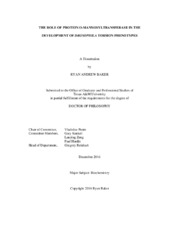| dc.description.abstract | Congenital muscular dystrophies (CMD’s) are serious diseases affecting muscle, brain, eye, and other tissues and often result in premature death of patients. These forms of muscular dystrophy are largely underlain by defects in the glycosylation of dystroglycan, and specifically by defects in the O-mannosylation pathway. The fruit fly Drosophila melanogaster is a good model system for studying many genetic diseases, including CMD’s, as they utilize many of the same molecular processes as mammals. They have homologues of mammalian Protein O-MannosylTransferase (POMT) 1 and 2 which have been shown to O-mannosylate dystroglycan.
In this dissertation I studied the biological defects associated with POMT mutations primarily by using a live imaging approach in Drosophila. In Drosophila the most prominent defect associated with POMT mutations is a clockwise torsion of posterior abdominal segments relative to anterior segments. The mechanism by which this torsion arises was not previously known.
Here I characterized the gross physiological mechanism by which torsion arises. I showed that it is present at the embryonic stage, that embryos undergo chiral rolling within their shells during peristaltic contractions, and that abnormal contraction patterning in POMT mutants leads to differential rolling that gives rise to torsion of the dorsal midline.
I next demonstrated the cellular requirements for POMT in maintaining proper posture. I showed that POMT is required in the peripheral nervous system to mediate proper feedback to the central nervous system for regulation of contraction patterning. Aberrations in the development of the peripheral nervous system can also cause torsion, even when POMT is functional. Additionally, I showed that muscle tissue and possibly epidermis and central nervous system cells require POMT expression to maintain posture.
Finally, I investigated the molecular targets of O-mannosylation. I showed that O-mannosylation of dystroglycan is involved in the rise of torsion, but that it is not the only relevant target. The receptor protein tyrosine phosphatase RPTP69D is also O-mannosylated and plays a role in both neuronal and muscle tissues in regulating posture.
These results shed light on the biological mechanisms underlying muscular dystrophy, and may lead to new targets for diagnosis and therapy in human patients. | en |


